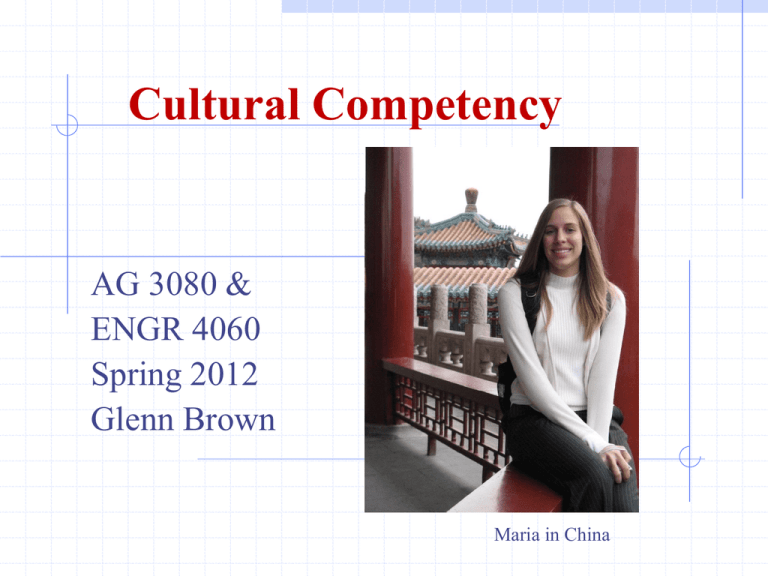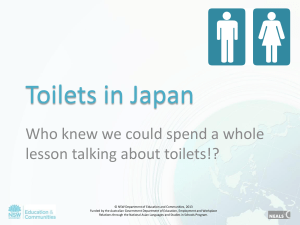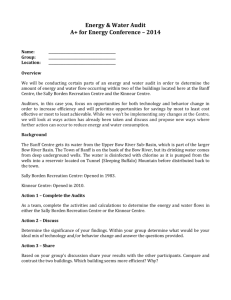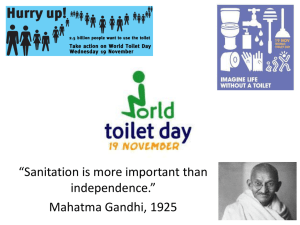Cultural Competency
advertisement

Cultural Competency AG 3080 & ENGR 4060 Spring 2012 Glenn Brown Maria in China Cultural Competency We want you to be able to interact effectively with your hosts, that is, to be Culturally Competent. To do so: Be aware of the unique aspects of your own culture, Be looking for differences in cultural norms, Try not to offend your hosts with your normal behavior, and Make an effort to understand the underlying “raison d'être” for the cultural differences. OSU students meeting Alston engineer Iceberg Theory of Culture Y ou (at fu ll sp eed ) F ood, A rt, A rchitecture L aw s, R eligion, B ody L anguage, M orals, N ature of F riendship, T em po of L ife, N otions of L eadership, C hild R aising, C oncepts of B eauty, P ersonal S pace, C ourtship, N otions of M odesty, etc Culture Culture is all the knowledge, beliefs and values shared by a society. It is a uniquely human characteristic, and consists of four major components: Language, Laws, morals, and religion, Social customs and norms, and Technology Culture is a learned way of acting and Revolutionary monument in China. thinking, as opposed to instinctive reactions. A society develops and maintains a culture, and an individual learns it. Language The language, including body language, is the glue of the culture and reflects the society and the special communication needs they may have. As a simple example, the Inuit have the words: Aput: 'snow on the ground‘, Gana: 'falling snow‘, Piqsirpoq: 'drifting snow‘, and Qimuqsuq: 'a snow drift’. An example of a translation by a nonEnglish speaker. How is your Chinese? The easiest way to offend people is not to use at least a little of their language. Laws, Morals and Religion These are the hard values. They govern the liberties and limits of a person’s life. They include rules on political governance, personal behavior, and faith. These aspects must be respected on risk of punishment. All cultures have these, and the differences between cultures are where serious difficulties can occur. The best known example is women’s dress in some Muslin countries. Western women are expected to follow the same dress as the locals; covered hair and no exposed skin except for the face and hands. Keep in mind, it’s their country. Social Customs and Norms These are the important traditions, which many think of first when they discuss culture. Examples are: Art, architecture and music, Food and drink, Public behavior, and Work ethic. Bologna, Italy Sometimes local social norms are quite different. Italians are much more “outgoing”. Women should be prepared for what we consider rude behavior from strangers. They think they are paying you a compliment. Technology Technology is the last, and many times greatly underestimated, factor in culture. Think about your A really cool bridge; Milau viaduct 343 m tall, 2,460 m long , France. own use of technology; plumbing, automobiles, planes, cell phones, the web, etc. How would your life change if you didn’t have them? As engineers and scientists, we are the stewards of our culture’s technology and are the best observers of a foreign culture’s technology. Technology not only shapes societies, societies also shape technology to suit their needs. Consider how we use trains, compared to the Europeans. Technology An American, diesel unit-train transporting 10,000 tons of coal at 60 mph, vs. a French, electric TGV carrying 400 passengers at 200 mph; different, but both great technical achievements. Toilet Tech Toilets provide a simple and interesting case study. A bath at Ca’Tron, Italy Toilet Tech livegreenstlouis.wordpress.com Standard Design. In the US the lever handle on the side, while in Europe there is a push button on the top. Some technology is different, but equivalent. www.treehugger.com Toilet Tech Advances. In the USA we set regulations to limit toilets to 1.6 gallon per flush, for lowering water use. Elsewhere, they have introduced #1 and #2 flush functions. www.plumbingsupply.com Some developments differ, but address the same problem. Toilet Tech Behavior. Pit Toilets design is tied to the local notions of “normal”. You are not probably never going to see these here. However, note the tile surfaces and the hose. Pit toilets can be easily washed down, so they are considered cleaner in public applications. Don’t be quick to judge. (Do you want to sit on a dirty seat?) Dr. Carol Jones Toilet Tech Exotic. Bidets were developed in France in the 18th century and have spread to Italy, Greece, Japan and elsewhere. (These are not toilets, per se, but are wash basins for your bottom and feet.) After some Americans use these, they have installed them in their homes. Some foreign technology may have at least limited application here. www.knowledgerush.com Toilet Tech High Tech. Toto in Japan has been pushing the envelope in toilet engineering. This $5,000 toilet, intended for elder care, analyses the user’s urine and blood. Data is autodownloaded to doctor. Perhaps a technological misfire, but if you are a toilet producer, you probably should at least stay informed. www.physorg.com Technology Observations We want you to focus on the technological aspects of the foreign culture. Consider: What technology is used, How it differs from ours, and Why it differs from ours. Open storage of parts at John Deere in China Remember, generally technology is neither good nor bad, it just is. However, as engineers we can judge (privately) what is equivalent, what is different but not better, what is not appropriate for our society, and what may be a technology we should consider adopting. Cultural Competency Remember, your judgment is based on the American culture and environment. Your foreign hosts not only have a different culture, but may have significantly different restrictions and opportunities. As an example, the John Deere Plant in Arc-les-Gray, France, makes two dozen models of hay balers. Many are functionally equivalent. In the USA, we would have at most six models. However to sell machines, the French plant must conform to local expectations throughout Europe. They not only have to make different models for France and Germany, they have different models for Northern and Southern Germany. Don’t be quick to judge. Figure out why. Understanding Our Cultural The beginning of cultural competency is to understand what is unique about our own culture. http://okctalk.com “American Culture” (L. Robert Kohls) 1. Personal control over the environment 2. Change 3. Time and its control 4. Equality/Egalitarianism 5. Individualism and privacy 6. Self-help concept The OK Land Run: See 7. Competition and free enterprise 1, 2, 3, 4, 5, 6, and 7. Understanding Our Cultural 8. Future orientation 9. Action/work orientation 10. Informality 11. Directness, openness and honesty 12. Practicality and efficiency 13. Materialism/acquisitions Natural gas drill site. See 8, 9, 10, 11, 12 and 13. Halliburton.com How Not to Offend The most important step in cultural competency is to try and adjust your behavior to the foreign norms. “Un-American Culture” (Glenn Brown) 1. Personal control over the environment: Go with the flow. Don’t worry, be happy. 2. Change: Don’t comment on stuff that seems “old fashion” to you. Don’t be quick to suggest “improvements”. 3. Time and its control. Do less, don’t rush. Do not expect to be served lunch in two minutes. Waiting for the bus in Italy by D. Turner DataLogic in Bologna, by Glenn Brown How Not to Offend 4. Equality/Egalitarianism: Be aware of people’s stature in their society. Seniors, professionals, police, etc. should be treated with extra respect. 5. Individualism and privacy: Don’t expect to have private tables in full restaurants. Some public restrooms may be for both genders. 6. Self-help concept: If someone wants to help you with something, let them, as long as it is within reason. 7. Competition and free enterprise: Don’t play basketball like you are in a pickup game in the Colvin Center. Don’t mention the host country’s “socialism”. How Not to Offend Enjoying the day in Tuscany 8. Future orientation: Just try to enjoy the day. Let tomorrow take care of its self. 9. Action/work orientation: See 3 & 8. 10. Informality: Be more formal with everyone and dress better than you would here. 11. Directness, openness and honesty: Be more reserve. Don’t lie, but hold your cards close to your chest. 12. Practicality and efficiency: Don’t expect either. Some things, like getting tickets, will take time. 13. Materialism/acquisitions: Don’t show off your stuff. Language and Conversation Learn as much of the native language as you can. Always greet people in the native language. Always answer “yes” or “no” in the native language. Start conversations with a compliment of the host country. Mention that you are appreciative A conversation in France of the opportunity to travel in their country. Even if asked, do not say what you do not like about the host country. If pressured, just say what is “different”. When in doubt, be very polite, soft spoken and deferential. Social customs and norms Be observant. Just watch people and note how the locals act and behave. Notice how close people stand next to one another in lines; how do you approach someone to ask a question, etc. Try to imitate their behavior. As an example, in France when you eat you don’t put your elbows on the table, nor do you put your free hand in your lap. Proper etiquette is to rest the wrist of your free hand on the Table. Watch and learn. Barb Brown in Bologna Food A group meal in China. Everyone is using chop sticks; a class requirement. Food Be adventurous when you eat! Most foreign foods are good. There may be a few things that require you to acquire a taste. There may be dishes that you just will not care for. Just be opened minded. As an example, in China they eat every animal and every part of the animal. When you order chicken, you get the whole bird cut up in small parts, including the head and feet. That is not a problem. You don’t have to eat everything that is put in front of you. (A running joke is not to ask what you are served.) If you go to McDonalds, you flunk the class. Cultural Adjustment Curve While some of you may enjoy every moment of your travels, it is more common for people to go through up and down periods. For short trips there are four phases: Anticipated Departure Low: Wariness of challenges to come. Initial Emotional High: Excitement with new and novel experiences. Everything is great and better. “Culture Shock”: Novelty wears off, and frustration and annoyances with common activities become significant. Adjustment: Seeing the balance between positive and negative aspects of the foreign culture. Just be prepared for the changes you will experience. Cultural Competency Summary To be Culturally Competent: Be aware of the unique aspects of your own culture, Be looking for differences in cultural norms, Try not to offend your hosts with your normal behavior, and Make an effort to understand the underlying “raison d'être” for the cultural differences. And of course, Enjoy ! Nikki at Pont du Gard Cultural Competency Assignment Interview a Chinese student. Go through Kohl’s 13 American Values. You can just read Kohl’s paper. Determine what you have in common and where you differ. Write it up, with a stress on any differences.











